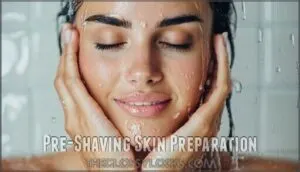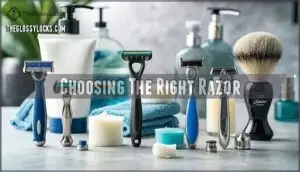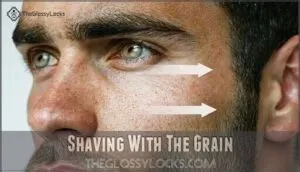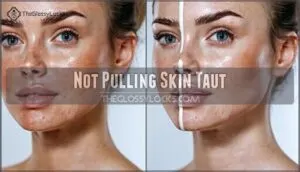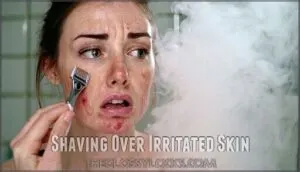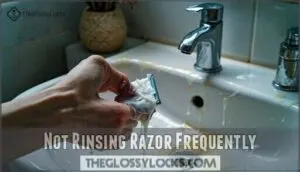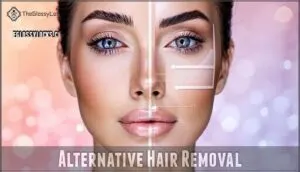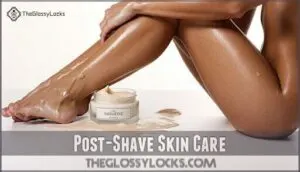This site is supported by our readers. We may earn a commission, at no cost to you, if you purchase through links.
 Regarding shaving tips for women’s face, preparation is your best friend. Start by cleansing your skin with warm water to soften hair follicles, then apply a gentle shaving cream or oil.
Regarding shaving tips for women’s face, preparation is your best friend. Start by cleansing your skin with warm water to soften hair follicles, then apply a gentle shaving cream or oil.
Use a clean, sharp razor designed for sensitive skin, and always shave in the direction of hair growth using light, short strokes. Don’t press too hard – let the razor do the work.
Pull your skin taut in tricky areas like around your chin or upper lip. Rinse your blade frequently to prevent clogging.
Immediately after shaving, apply an alcohol-free moisturizer to soothe your skin. The secret to mastering this routine lies in understanding your skin’s unique patterns and timing, and having a good routine.
Table Of Contents
Key Takeaways
- Prep your skin properly – You’ll get better results when you cleanse with warm water, apply shaving cream or oil, and pull your skin taut in tricky areas like your chin and upper lip.
- Choose the right tools and technique – You should use a clean, sharp razor designed for sensitive skin and always shave in the direction of hair growth with light, short strokes instead of pressing hard.
- Avoid common mistakes that cause irritation – Do not shave over irritated skin, replace dull blades after five uses, and rinse your razor frequently to prevent clogging and bacteria buildup.
- Follow up with proper aftercare – You need to rinse with cool water immediately after shaving, apply an alcohol-free moisturizer to soothe your skin, and use sunscreen to protect your newly exposed skin from UV damage.
Facial Hair Basics
You’ll find two main types of facial hair on your skin: fine, translucent vellus hair that covers most areas, and darker, thicker terminal hair that grows along your lips, chin, and jawline.
Your genetics and hormones work together to determine how much facial hair you have, where it grows, and how visible it appears.
Vellus Hair Characteristics
You’ve probably noticed that soft, barely-there hair covering most of your face – that’s vellus hair, commonly called peach fuzz.
This fine, translucent hair serves important vellus functions like temperature regulation and sweat evaporation.
Unlike coarse hair, vellus hair’s delicate texture makes it nearly invisible, creating that natural glow many women seek when considering facial shaving options.
Terminal Hair Characteristics
Terminal hair represents the darker, coarser strands you’ll find on your upper lip, chin, and jawline.
Unlike fine vellus hair, terminal hair’s thickness and visibility make it more noticeable on women’s faces, with genetic influence determining its density and color.
- Genetic influence controls your natural hair color and growth patterns
- Hormonal conditions can trigger unexpected terminal hair development in new areas
- Hair thickness varies substantially between individuals, affecting overall facial hair types appearance
Hormonal Influence on Hair Growth
Your hormones act as the puppet master behind facial hair growth.
Your genetics and hormones team up as the ultimate architects of your facial hair destiny.
Conditions like PCOS and hirsutism can trigger unexpected hair development, while menopause effects often surprise women with new growth patterns.
CAH symptoms and Cushing’s syndrome also influence hair density.
Understanding these hormonal irregularities helps you recognize when facial hair causes stem from internal changes rather than genetics alone.
Estrogen levels substantially impact hair, as they stimulate follicles during the anagen growth phase.
Genetic Factors Affecting Hair Density
Your genetic blueprint determines much more than eye color—it shapes your facial hair destiny too.
Hereditary hairline patterns and hair follicle density vary dramatically across ethnic variations, creating unique genetic predisposition profiles.
Some women inherit thick, visible women’s facial hair due to hormonal gene influence, while others barely develop peach fuzz.
Understanding these genetic factors helps you choose appropriate removal methods for your specific hair type.
Genes also influence overall hair thickness, impacting hair removal choices.
Shaving Techniques Matter
Your technique determines whether you’ll achieve smooth, comfortable results or face irritation and razor burn.
Using proper shaving methods, including correct razor angle and stroke direction, protects your skin while effectively removing facial hair, which is crucial for achieving smooth results.
Pre-Shaving Skin Preparation
Now that you understand your facial hair basics, proper skin preparation sets the stage for irritation-free shaving.
Your face deserves the same attention you’d give before applying makeup.
Follow these preparation steps:
- Cleanse Thoroughly with gentle cleanser to remove oils and debris
- Exfoliate Gently using soft washcloth for smoother surface
- Hydration Importance – apply warm water to soften hair
- Taut Skin preparation reduces nicks and cuts
- Razor Prep guarantees clean, sharp blade performance
Using a quality facial cleanser is essential.
Choosing The Right Razor
Your razor choice directly impacts your shaving success. Face-specific razors differ substantially from body razors, requiring careful consideration of several factors.
| Razor Type | Best For | Key Benefits |
|---|---|---|
| L-shaped facial razors | Sensitive skin | Precise control, gentle touch |
| Single-blade tools | Peach fuzz removal | Minimal irritation, clean cuts |
| Dermaplaning devices | Professional results | Vibration assistance, superior precision |
| Electric razors | Quick touch-ups | Convenient, reduces nicks |
Blade Material matters substantially. Stainless steel blades stay sharper longer, while ceramic options work well for sensitive skin. Handle Ergonomics affect control—choose grips that feel comfortable in your hand.
Consider your Skin Sensitivity when selecting blade sharpness and protective features. For quick and easy touch-ups, the Finishing Touch Flawless is a great choice.
Shaving With The Grain
Following your hair’s natural growth pattern creates the foundation for smooth shaving without irritation.
Most facial hair grows downward, so you’ll want to move your razor in that same direction.
Here’s your hair grain direction strategy:
- Observe your hair growth – Look closely at how your facial hair naturally lies
- Match your razor angle – Keep the blade at 15 degrees following the hair’s path
- Use gentle strokes – Light pressure prevents ingrowns while maintaining control
Avoiding Sensitive Areas
When shaving the direction of hair growth, you’ll need to navigate around delicate facial zones.
The lip area and eye proximity require extra caution, while jawline concerns and nose contours demand gentle handling.
Neck sensitivity varies by person, making these face shaving tips essential for preventing razor burn and skin irritation.
To improve shaving results, consider pre-shave skin preparation detailed online.
| Sensitive Area | Shaving Approach |
|---|---|
| Lip Area | Skip upper lip; use tweezers instead |
| Eye Proximity | Avoid within 1 inch of eyes completely |
| Jawline Concerns | Use extra light pressure, short strokes |
| Nose Contours | Shave around, not directly on curves |
| Neck Sensitivity | Test small patch first for reactions |
Common Shaving Mistakes
Even experienced shavers can fall into habits that lead to irritation, cuts, or poor results when removing facial hair.
Even the most careful shavers make mistakes that turn a simple routine into a painful ordeal.
Understanding these common mistakes will help you achieve smoother skin while avoiding damage that can take days to heal, which is crucial for maintaining healthy skin and avoiding irritation.
Not Pulling Skin Taut
Loose skin creates multiple facial shaving challenges that compromise your results.
When you don’t pull skin taut, you’re setting yourself up for an uneven shave that leaves missed hairs and increases cutting risk.
Here’s what happens without proper skin tension:
- Skin laxity causes the razor to skip over hair follicles
- Razor burn develops from repeated passes over the same area
- Missed hairs remain, requiring additional shaving attempts
Using Dull Blades
Dull blades drag across your skin instead of gliding smoothly, creating blade drag that leads to razor burn and irritation increase.
You’ll need multiple passes over the same area, causing ineffective exfoliation and heightening infection risk.
Replace your razor after five uses or when it feels rough, as sharp blades are non-negotiable for safe women’s facial shaving.
To avoid this, consider extending razor blade life with proper care.
Shaving Over Irritated Skin
Irritated skin needs time to heal before you pick up that razor again.
Shaving sensitive skin while it’s already inflamed creates a painful cycle that’s hard to break. Your face deserves better treatment than this self-inflicted torture.
Here are key preventative measures for managing skin irritation:
- Avoid shaving for 24-48 hours after noticing redness or bumps
- Apply soothing ingredients like aloe vera or chamomile to calm inflammation
- Check product ingredients for alcohol or fragrances that worsen irritation
- Identify skin conditions like eczema that require special care
- Use healing methods such as cool compresses to reduce razor burn
Not Rinsing Razor Frequently
Skipping blade rinses creates a perfect storm for your skin.
Hair, dead skin cells, and shaving cream quickly clog your razor, turning each stroke into a bumpy ride. Clean blades glide smoothly while dirty ones drag and pull.
| Problem | Solution |
|---|---|
| Blade Bacteria | Rinse after every 2-3 strokes |
| Clogged Blades | Use warm running water |
| Reduced Efficiency | Tap razor on sink edge |
| Skin Irritation | Keep blade debris-free |
Alternative Hair Removal
While shaving offers quick results, you’ll find several other methods that can effectively remove facial hair with different benefits and timeframes.
These alternatives include waxing for longer-lasting results, laser treatments for semi-permanent reduction, and threading for precise hair removal around delicate areas.
Waxing and Its Effects
Waxing pulls hair from the root, offering longer-lasting results than shaving but requiring careful consideration of potential drawbacks.
Here are five key effects of facial waxing you should know:
- Waxing irritation can cause redness and sensitivity lasting several days
- Hair length must reach quarter-inch minimum for effective vellus removal
- Painful waxes around sensitive areas like upper lip waxes require tolerance
- Ingrown hairs may develop as hair regrows beneath skin surface
- Waxing cost adds up with regular salon visits for terminal reduction
Over time, regular waxing can lead to slower hair regrowth.
Laser Hair Removal Benefits
Laser hair removal offers impressive hair reduction permanence compared to temporary methods.
This dermatological treatment works best on darker hair and various skin tone suitability levels.
Treatment area options include upper lip, chin, and cheeks with minimal side effects.
While initial cost effectiveness seems lower than shaving, long-term hair removal benefits make it worthwhile for those seeking lasting hair removal alternatives.
Chemical Hair Removal Methods
Chemical hair removal methods offer convenient alternatives to traditional shaving.
Depilatory creams dissolve hair through chemical processes using alkaline ingredients that break down keratin proteins.
These hair removal alternatives require careful application techniques and consideration of skin sensitivity.
Always patch test before use, as neutralizing chemicals can cause irritation.
Chemical exfoliation occurs simultaneously, but hair removal risks include potential side effects like redness.
Threading and Dermaplaning
Professional threading and dermaplaning offer precise facial hair removal alternatives to traditional shaving.
Threading precision targets individual hairs while dermaplaning benefits include smoother skin texture and better makeup application.
Pain comparison varies between methods, with dermaplaning typically more comfortable than threading.
Key considerations for these peach fuzz removal methods:
- Skin suitability – Threading works on all skin types, while dermaplaning suits most complexions
- Cost analysis – Threading costs $15-30 per session, dermaplaning ranges $100-200 professionally
- Duration – Threading lasts 3-6 weeks, dermaplaning results fade within 3-4 weeks
Post-Shave Skin Care
After you’ve finished shaving your face, your skin needs proper care to prevent irritation and maintain smoothness.
You’ll want to rinse with cool water, apply a gentle moisturizer, and use sunscreen to protect your newly exposed skin from damage.
Hydrating and Soothing Skin
Right after shaving, rinse your face with cool water to close pores and reduce inflammation.
Gently pat your skin dry—never rub harshly.
Apply an alcohol-free moisturizer containing soothing ingredients like aloe vera to hydrate and calm irritated skin.
Consider using an alcohol-free skincare product for best results.
This essential postshave care routine prevents dryness and helps your skin recover from the mechanical exfoliation of shaving.
Applying Sunscreen
After moisturizing your freshly shaved skin, sunscreen becomes your protective shield.
Your newly exposed skin needs defense against harmful UV rays that can cause sunburn and increase skin cancer risk.
Here’s your sun protection game plan:
- Choose broad-spectrum SPF 30 or higher for complete coverage
- Apply sunscreen 15-20 minutes before stepping outside
- Reapply every two hours to maintain effective skin protection
Exfoliating for Smooth Skin
After protecting your freshly shaved skin with sunscreen, gentle exfoliation becomes your secret weapon for maintaining that silky-smooth feeling.
Wait 24-48 hours post-shave before introducing any exfoliation routine to avoid irritation on sensitive skin.
| Exfoliation Method | Best For | Frequency |
|---|---|---|
| Chemical Exfoliation (AHA/BHA) | Sensitive skin, daily use | 2-3 times weekly |
| Physical Exfoliation (gentle scrub) | Normal skin types | 1-2 times weekly |
| Enzyme exfoliants | Post-shave care | Once weekly |
| Microfiber cloths | Daily maintenance | Every other day |
| Exfoliating toners | Combination skin | 3-4 times weekly |
Proper facial exfoliation removes dead skin cells that can trap ingrown hairs, keeping your complexion radiant.
Chemical exfoliation with gentle acids works better than harsh scrubs for maintaining skin smoothness between shaving sessions.
Frequently Asked Questions (FAQs)
How often should women shave their face?
You’ll typically need to shave every two to three days, depending on your hair growth rate.
Some women shave weekly, while others prefer daily touch-ups for consistently smooth skin and ideal makeup application.
Can facial shaving cause acne breakouts?
Facial shaving can trigger breakouts if you’re not careful.
Using dirty razors, shaving over active acne, or skipping proper cleansing creates bacteria buildup.
Clean tools and gentle technique help prevent most shaving-related breakouts.
They are essential for maintaining good skin health and minimizing the risk of bacteria buildup.
Whats the best time of day to shave?
Mornings work best for shaving your face since your skin’s less sensitive and you’ll have time to address any irritation before bed.
You’re also more likely to have steady hands when you’re fresh and alert.
Should you shave before or after showering?
Shave after showering when your skin’s warm and softened.
The steam opens pores and makes hair easier to cut.
You’ll get a closer shave with less irritation than on cold, dry skin.
Can pregnant women safely shave their face?
Like smooth sailing on calm waters, facial shaving during pregnancy is generally safe.
You can continue your normal routine, but hormonal changes might make your skin more sensitive, so use gentle strokes and moisturize afterward.
Conclusion
Mastering these shaving tips for womens face transforms routine maintenance into confident self-care.
You’ve learned proper preparation techniques, discovered suitable razor selection methods, and understood post-shave care essentials.
Remember that consistency builds expertise, patience prevents irritation, and quality tools deliver superior results.
Your skin deserves gentle treatment and thoughtful attention.
Practice these techniques regularly, listen to your skin’s responses, and adjust your approach accordingly.
With time, you’ll develop a personalized routine that keeps your complexion smooth and radiant.
- https://theinia.com/a/blog/how-to-shave-your-face-face-shaving-tips-for-men-and-women
- https://www.clinikally.com/blogs/news/facial-shaving-for-women-benefits-and-best-practices
- https://pubmed.ncbi.nlm.nih.gov/34524781/
- https://depology.com/blogs/news/shaving-facial-hair-for-women
- https://www.gillettevenus.com/en-us/womens-shaving-guide/womens-hair-removal/hair-removal-methods-for-women/?srsltid=AfmBOop0t8ABHUILnJA5_PvJ9cNj2uE5tF8X6tcY_08kIQmgKyk3CDVp

